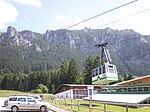Hohenschwangau Castle
Buildings and structures in OstallgäuCastles in BavariaHistoric house museums in GermanyMuseums in BavariaPalaces in Bavaria ... and 1 more
Royal residences in Bavaria

Hohenschwangau Castle (German: Schloss Hohenschwangau) is a 19th-century palace in southern Germany. It was the childhood residence of King Ludwig II of Bavaria and was built by his father, King Maximilian II of Bavaria. It is located in the German village of Hohenschwangau near the town of Füssen, part of the county of Ostallgäu in southwestern Bavaria, Germany, very close to the border with Austria.
Excerpt from the Wikipedia article Hohenschwangau Castle (License: CC BY-SA 3.0, Authors, Images).Hohenschwangau Castle
Alpseestraße,
Geographical coordinates (GPS) Address Website External links Nearby Places Show on map
Geographical coordinates (GPS)
| Latitude | Longitude |
|---|---|
| N 47.55557 ° | E 10.73605 ° |
Address
Schloss Hohenschwangau
Alpseestraße 30
87645
Bavaria, Germany
Open on Google Maps










